
EXPEDITION WILD

Trans-Kalahari, Botswana
Through the heart of the Kalahari desert
Expedition Basics:
12 day overland through the Central Kalahari Game Reserve
Land-cruiser 78 Series (Troopy)
Diesel: 220l - 1200km
Water: 110l - 5l/ day/p
Trip Report:
Night 1 & 2 Molose (Mo’lo’se)
Jhb - Khutse Game Reserve 12hr drive - 660km
Campsite 2
The first two nights we camped on a slight ridge overlooking a section of the grassy pan system that extended north to the only permanent waterhole within a 20km radius. Small herds of gemsbok, springbok and hartebeest were seen regularly around the waterhole, but the highlight was the birds: Gabar goshawk, Lesser Moorhen, black headed Grebe, Desert Cisticola, Kalahari Robin, double banded Courser, and our friendly resident Spotted Eagle Owl. We also had a great sighting of an African Wild Cat, and two oldish kittens playing on a fallen log.

 |  |  |
|---|---|---|
 |  |  |
 |
Night 3 - Bape
Campsite 2
7h - 100km
We left early, just as the sun was coming over the horizon, heading northwards via Mahurushele where we explored the large pan systems in the area, and spotted our first Secretary Birds. Heading north from there we made a stop at Khanke camp sites where we came across fresh leopard tracks, before pushing onwards into the Central Kalahari Game Reserve - CKGR and to Bape and our first lion tracks.
We had a few drops of rain throughout the morning and the temperature hovered around 14 degrees until noon when the sun joined the team and we were back into the 20’s - happy days!
We ended the day with an afternoon walk exploring our immediate surrounding.
 |  |  |
|---|---|---|
 | 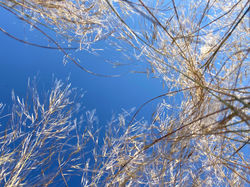 |  |
 |  |  |
Night 4 Xaxa Waterhole
116km - 7hrs
Early departure saw fresh elephant spoor and with a quick aerial view from the roof-rack we spotted our first Kalahari elephant, it was to become the day of elephants as we notched up another sighting on-route and few more bulls at Xaxa itself including giraffe and kudu. We also came across ‘hippo’ spoor which we where told later was also seen at Xaxa - very strange to see elephants this far into the Kalahari never mind a hippo!.
Xaxa is an amazing location surrounded by a sandy ridge on 3 sides, real wild camping.
 |  |  |
|---|---|---|
 |  |  |
Night 5 & 6 Piper Pan
Campsite 1 then 2
135km - 7hr
If the day before was elephants, today was all about the lions. We were woken up just before dawn by two male lions roaring as they did a large loop around us, only to learn later that they had already come past us, within 4m or so, to have a good look at what was on the menu - nothing appetising it seems!
Anyway, as the sun came up we set out looking for them and again from the roof rack we spotted two big male lions as they moved off slowly into the bush, both looking back at us in acknowledgement. We then set off for the day retracing our route out of Xaxa, to the junction where we then turned west to Xade and onto Piper Pan.
Piper was a total change to what we had seen before, the extensive, interconnected pan system stretches for what seems like kms. These large circular grass pans form open plains with loads of springbok, wildebeest, giraffe, kudu, and gemsbok, also plenty ground squirrels scattered throughout, and of-course lion! We were informed that a large, black maned lion was sleeping near the waterhole and as the sun was setting we spotted him walking along the edge of the pan where he eventually lay down and settled, and could be heard calling into the night.
During the night we could hear at least two other groups of lions calling in the distance, one from the North and a group from the South that moved closer and we would eventually meet, on the road, just before sun rise. This group comprised of two adult females and a sub-adult male and female. They were in hunting mode and the two adults moved ahead with the two sub-adults lagging behind. Eventually they moved off the road and soon flushed a bat eared fox, who in desperation to escape turned in the wrong direction and straight into the male - the game was over, sadly. They eventually lost interest in the fox and left it without eating it. As the heat of the day increased large numbers of vultures came in with atleast 20 Lapped-faced seen at one time, truly a rare sighting. A number of White-headed and White-backs also decided to join in. Piper pan was proving to be a productive area.
The second night we moved into camp site 1 on the ridge, behind the pan system, and enjoyed our drives around the pans. Notable are the unusual ———— trees only found or seen at piper, large heard of 50+ wildebeest and springbok, greater kestrels, and Lanner Falcon/s, one hunting doves at the waterhole with the two local Avocets and a Glossy Ibis.
 |  |  |
|---|---|---|
 |  |  |
 |  |
Night 7 & 8 Passarge Pan
Camp site 2
140km - 7hrs
We set off early before sunrise to enjoy our last views of Piper Pan and to see if we could track down the lions we had heard in the early morning. We took the northern loop and were fortunate enough to spot what we assumed were two large cheetah in the distance but they moved off the plain into the scrub as soon as we approached. We then backtracked to followup on some male lion tracks we had seen at the junction and after a bit of back and forth we spotted two big males sitting just in the short grass on the pan edge. After a while, two 6 - 8 month old cubs emerged playing in the short grass.
It was finally time to say goodbye to Piper Pan and off we set for Passarge, via the Phokoje and San Pans. The road makes a zigzag around these two pans with small groups of gemsbok, springbok with the odd solitary wildebeest seen. As you approach Passarge there is a noticeable change in vegetation with long extended acacia woodland sections following the sand ridges and as expected giraffe and the odd elephant spoor.
Passarge is a long, narrow pan system that runs west east with large trees forming small islands dotted throughout the pan. This area is dry and the only water hole was not working, nevertheless these desert hardy animals seems to still thrive. On our approach to the campsite we spotted what was probably our largest heard of Gemsbok to date of around 50, all in magnificent condition.
Our two days at Passarge was quiet but gave us time to relax and enjoy our surroundings. The highlight of this area was exploring the acacia woodlands in the pan system and the many new bird species, notably our first woodpecker - a Cardinal, Barred Wren-Warbler, Greater spotted Cuckoo, Capped Wheatear, Red-Capped Lark, Grey Backed-Sparrow-Lark... It is also a great area for Bat-eared Fox and we got to see a fleeting view of a Cape Fox.
Night 9
Leopard Pan & Camp site
43 km - 2 hrs
It was a great drive out of the Passarge valley, via camp site 1 and onto Leopard and Sunday Pans. Much larger trees, and noticeably more vegetation than any of the other pans we have visited. We had a nice sighting of an African Wild Cat on the edge of one of the many Acacia woodlands on the way out.
Leopard Pan is circular in shape and has a large raised island in the middle, the main waterhole in the area is at Sunday Pan 7 kms South. The pan is a large, oblong, open pan with a waterhole on the one edge, and two amazing campsites (3&4) nestled above overlooking the pan from a sand ridge. Noticeable are the many large Terminalia Prunioides trees, with their purple winged seed pods, that forest these ridges making good camping sites. Tracks of leopard, lion, cheetah and hyaena where seen but managed to evade us today.
 |  |  |
|---|---|---|
 | 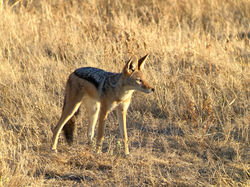 |  |
 |  |  |
Night 10
Deception Valley
Camp site - HATIB 1
34km - 1hour
It was a quiet night but once we were up we noticed fresh lion tracks that came up the road into our camp and around my tent! This time coming within 1m or so. It looked like two sets of tracks and they must have just come through because as we left camp we spotted one female just on the pans edge. She looked interested in some Gemsbok but soon moved off the pan and lay down. We waited while having a coffee break with a curious black-backed jackal who soon flushed an African Wild Cat and the two had a ‘domestic’ cat and dog standoff, more curiosity from the young jackal but the wild cat was not keen on making friends!
With no sign of the lions, we then headed South to Deception Valley via Sunday Pan, spotting a puff adder on route.
Deception is a large, extended pan system that seems to terminate at Deception Pan, a clay based pan dry at this time of the year but our first clay pan we had seen. There is no waterhole at Deception and it hits home just how non dependent these Kalahari animals are on water. We saw many Gemsbok, one very large 60+ heard on the pan, Springbok, Giraffe, lone wildebeest, Hartebeest, and small groups of Ostriches dotted all over the pan and surrounding bush. We also came across another Bat-Eared Fox that had fallen victim to some predator with a number of Lapped-Faced Vultures in attendance.
But all good things come to an end and it was finally time to leave the CKGR and we made our way east to Matswere Gate.
A passing thought as we left this unique environment: It seems that with the recent good rains in the region the animals and plants have flourished. Mice were everywhere, which caused a few problems with fellow travellers as they tucked into the engine wiring and cooling pipes, and no doubt influenced the large numbers of Black-Backed Jackals, Pale Chanting Goshawks and Gabar Goshawks, with the majority being juveniles - all no doubt a result of the bountiful harvest the last season brought.
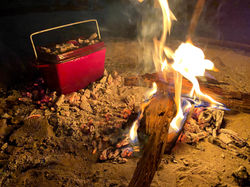 |  |  |
|---|---|---|
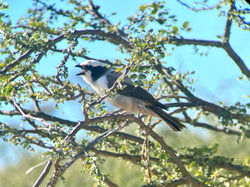 |  | 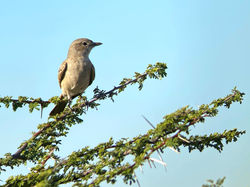 |
 |